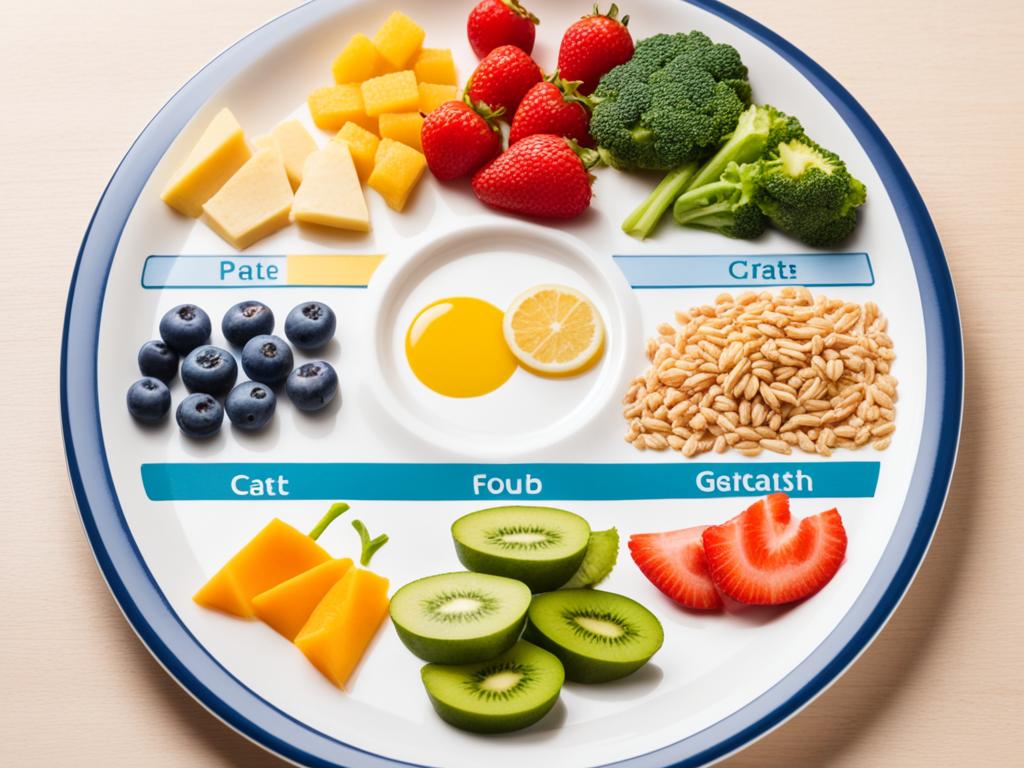
Dietary Guidelines: Eating for Better Health
Keeping a balanced diet is key for good health. Health experts give us dietary guidelines on how to eat right for the best health. These guidelines help us make smart food choices to keep our bodies healthy and lower the risk of diet-related diseases.
The guidelines suggest how much of each nutrient we should eat. This includes carbs, proteins, fats, vitamins, and minerals. Following these guidelines helps our bodies get what it needs to work right. It also helps prevent serious health issues like heart disease, diabetes, and some cancers.

Health organizations create these guidelines using the latest science and expert advice. They give us a clear plan for healthy eating habits. By following these guidelines, we can make better food choices. This leads to better health and helps us make informed decisions about what we eat.
Understanding Dietary Guidelines
Dietary guidelines are science-based advice for a healthy diet. They are made by health experts to help people stay well and avoid diet-related illnesses. It’s important to know about these guidelines to make smart choices about what to eat.
What Are Dietary Guidelines?
Dietary guidelines offer advice on what foods and drinks to eat for good health. They cover the main food groups, how much to eat, and the right balance of nutrients. This includes carbs, proteins, fats, vitamins, and minerals for a balanced diet.
Importance of Following Dietary Guidelines
Following dietary guidelines is key for many reasons:
- Balanced Nutrition: These guidelines help people get the right amount of nutrients. This reduces the risk of not getting enough or too much of certain nutrients.
- Chronic Disease Prevention: Eating right can prevent chronic diseases like heart disease, type 2 diabetes, and some cancers. It promotes healthy eating habits.
- Improved Overall Health: A diet based on these guidelines can lead to better weight control, more energy, and better physical and mental health.
By following dietary guidelines, people can make better food choices. This helps them maintain a healthy diet that supports their health over time.

Dietary Guidelines for Americans
The Dietary Guidelines for Americans are made by the USDA and HHS. They offer advice on healthy eating to prevent chronic diseases. These guidelines are based on science.
The latest guidelines stress the need for a balanced diet. They suggest eating foods from all food groups and following the MyPlate guidelines. The main advice is:
- Focus on variety, nutrient density, and amount: Eat a variety of foods in the right amounts. This helps meet your calorie needs and supports health.
- Limit foods and beverages higher in added sugars, saturated fat, and sodium: Cut down on these to help keep your diet balanced. This can lower the risk of chronic diseases.
- Shift to healthier food and beverage choices: Pick whole, less processed foods. Limit ultra-processed items that are high in sugars, sodium, and unhealthy fats.
- Support healthy eating patterns throughout all life stages: Adjust nutrition recommendations for different life stages. This includes from infancy to older adulthood.
Following the Dietary Guidelines for Americans helps make better food choices. This can improve your health and well-being. These guidelines are useful for healthcare workers, policymakers, and everyone. They help promote dietary guidelines and create a healthier food scene.

Exploring the Food Pyramid
The way we get dietary advice has changed, moving from the old food pyramid to the newer MyPlate. These guides help us eat right by showing how to mix different foods for good health. They stress the need for a variety of foods that are full of nutrients.
Building a Balanced Diet
The food pyramid and MyPlate show us how much of each food group we should eat. Here are the main groups:
- Grains: Whole grains like whole wheat, oats, and brown rice are key for a balanced diet.
- Fruits and Vegetables: Eating a mix of colorful fruits and veggies is important for getting vitamins, minerals, and fiber.
- Proteins: Lean proteins from poultry, fish, beans, and nuts help build and fix body tissues.
- Dairy: Dairy items like milk, yogurt, and cheese give us calcium and other nutrients for strong bones.
By using food pyramids and MyPlate guidelines, we can make sure we eat the right food groups in the right amounts. This helps us get a balanced diet and meet our macro/micronutrient intake needs.

Dietary Guidelines and Chronic Disease Prevention
Following dietary guidelines is key to preventing chronic diseases. A diet full of fruits, veggies, whole grains, and lean proteins lowers the risk of heart disease, type 2 diabetes, and some cancers. Eating foods rich in nutrients and avoiding too much fat, sugar, and salt helps keep a healthy weight and boosts heart and metabolic health.
Not getting enough vitamins and minerals can lead to chronic diseases. The dietary guidelines help make sure people get the nutrients they need. These nutrients are important for a strong immune system, healthy bones, and organs working right. By eating right, people can lower their risk of diet-related diseases and live healthier.
Using the dietary guidelines in everyday meals is a smart way to prevent chronic diseases. Making smart food choices helps people manage their health and cut down on doctor visits. As we learn more about diet and disease, sticking to these guidelines is seen as a key to staying well and easing the load on healthcare.
FAQ
What are dietary guidelines?
Dietary guidelines are advice from government agencies and health groups. They help people eat well and lower the risk of diet-related diseases. These guidelines suggest the best foods, nutrients, and eating habits for good health.
Why are dietary guidelines important?
They are key for making smart food choices and meeting nutritional needs. Following these guidelines can prevent chronic health issues. It helps keep a balanced diet, avoids nutritional shortages, and lowers the risk of heart disease, diabetes, and some cancers.
What are the key components of the Dietary Guidelines for Americans?
The main parts of the Dietary Guidelines for Americans are: – Eating a mix of nutrient-rich foods from all groups – Cutting down on added sugars, saturated fats, and sodium – Being active regularly – Keeping a healthy weight – Not drinking too much alcohol
How has the food pyramid evolved over time?
The food pyramid started in the 1970s and has changed a lot since then. Now, we have MyPlate, which shows the right food proportions on a plate. It tells us to eat a variety of fruits, veggies, grains, proteins, and dairy in the right amounts.
How can dietary guidelines help prevent chronic diseases?
Dietary guidelines are key in preventing chronic diseases by promoting healthy eating. By following them, people can get the right balance of nutrients. This lowers the risk of heart disease, type 2 diabetes, some cancers, and other diet-related illnesses. Sticking to these guidelines also helps with weight management and overall health.



Balance diet is very necessary for healthy living.